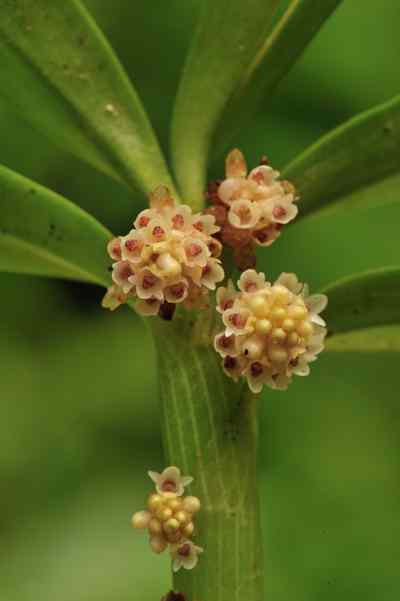The Plant
Epiphyte. Whole plant less than 15 cm in height. Erect or pendulous. Rhizome thick, covered with many fibrous sheaths. Pseudo-stems many, arising together from the rhizomes. Stems sub-cylindric or in many cases compressed, 7 to 9 cm long and around 1 to 2 cm thick. Leaves 4 to 6 in numbers arising from the apex of the stem, 5 to 7 cm long and 1 to 2 cm in width, lanceolate, tapering to both sides, with 2 to 3 cm long translucent and veined sheaths.
The Flower
Flowers in dense capitulum, arising in short peduncles from the axils of the leaves. Capitulum 2 to 2.5 cm across with 12 to 26 minute flowers. Sepals oblong to obtuse, erect. Petals much narrower, spreading. Lip oblong, three lobed, disc ridged. Lateral lobes, short, erect. The mid lobe deeply cut into two lobules.
Sepals and petals translucent, pale pink. Lip of a creamy white shade. Column brownish red.

The Pursuit
This is a plant never been studied from its natural habitats of Sikkim-Himalayas. With very little information available – including a question mark (?) on its blooming time by the authors, this was one of the most interesting pursuit made by me in the region. The only reference made was that the species is found in the tropical valleys and the blooming season as “August?”.
Between the months of May and October I always concentrated on orchids from the higher altitudes. But, I had always found time to come down to tropical valleys in search of many species and succeeded in finding many in bloom. King and Pantling in many cases mentioned some indications like Teesta valley, Frontier regions etc., so that the search can be done in those areas. In this case, it was only mentioned “Tropical valleys”. I tried several locations between the months of April and September in 2011, but was unable to locate this species. In 2012, I was taking a long trek along with my assistant and my assistant in a heavy forested region in the tropical zone to document another plant we had spotted few months back. The location was around 6 to 7 hours trek from the nearest village and it was impossible to return on the same day. Hence, we were carrying tents, food etc for the day. Midway, we were cooking our lunch on the banks of the stream we were following. My assistant boy was a local of the region and had the art of making utensils like spoons, glasses etc. from bamboos and plates from leaves for serving food. He was able to find few bamboos from near the stream, but was not able to collect wide leaves to make plates. As he was looking after the cooking, I went inside the thick forest to bring few wide leaves. While inside the forest, I found two orchids in bloom which I had already documented a year ago. Those finds made me do some survey in that location, with my mind saying “I will find something more”. Usually it has been advised by the Forest officials not to venture deep inside the forest all alone. As I was already inside the thick forest, I decided to do a quick survey and was constantly in touch with my helper by blowing whistles (a way of communication inside thick forests).
The forest was very thick, so movement as well as locating plants from tree tops were not easy. Within five minutes I came across two fallen trees. Fallen trees are always a home to many wild orchids. To my surprise I found a two stemmed single plant of this species with almost dried flowers. I was so excited I ran back to the stream to bring my camera and my assistant to help me. We searched the whole area for more plants with fresh flowers, but never able to locate anymore. As the plants were on a fallen tree, I started documenting the flowers without any help from my assistant. However, he used that time to climb few trees near by for a closer survey and was lucky to find another cluster of this species with fresh flowers. I too climbed up that tree and produced this beautiful photograph, probably the first of its kind from the region. Thus updating the information of its blooming time with more accuracy.
We both were returning so happy just to see a herd of 21 elephants on the stream enjoying their bath after smashing off our lunch and my beautiful tent and back pack!!!.
Reference:
King, G. & Pantling, R. (1898). The Orchids of the Sikkim-Himalayas. Ann. Roy. Bot. Garden.(Calcutta). Eria pumila, Lindl., Page no 118 – 119.